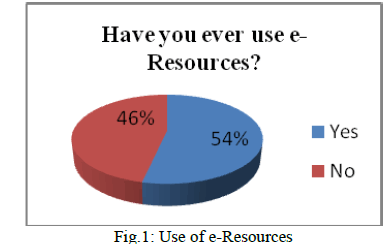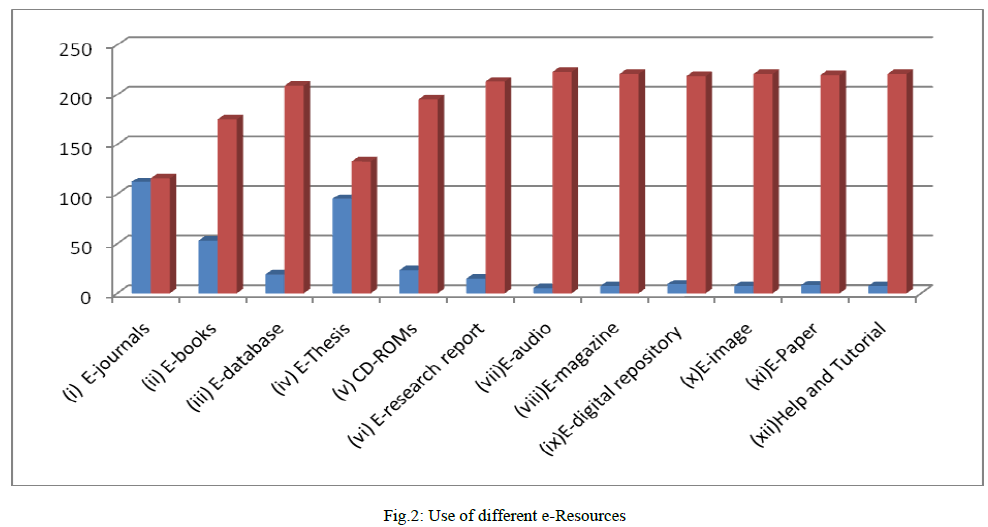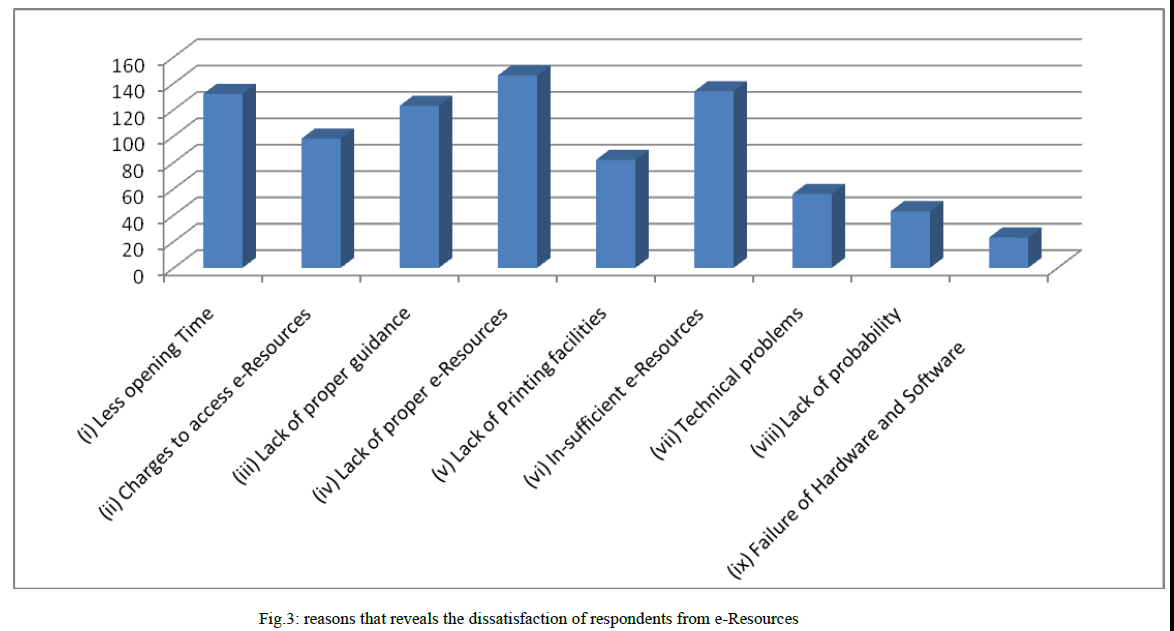ISSN ONLINE(2320-9801) PRINT (2320-9798)
ISSN ONLINE(2320-9801) PRINT (2320-9798)
Dr. Pardeep Mittal1, Monu Bala2
|
| Related article at Pubmed, Scholar Google |
Visit for more related articles at International Journal of Innovative Research in Computer and Communication Engineering
e-Resources or “electronic resources” can be defined as the resources available on the internet which are a godown of data and information on different subjects and topics. The e-Resources are available in universities/colleges. The study aimed at finding the use of e-Resources by the research scholar, students and faculties in universities and colleges. Majority of the respondents use e-Resources for educational purposes, the respondents use the e-Resources for research work. But they do not get any training from university library; they learn to use e- Resources either by self instructions or with guidance from colleagues and friends. The e-Resources can be accessed by the respondents at different places such as university and at home. It is also found from the analysis that most of the users are not giving enough facility for the use of e-Resources.
Keywords |
| e-Books, e-Journals, e-Resources, Research Scholars, universities. |
INTRODUCTION |
| e-Resources refer to those materials they require computer access, whether through a personal computer mainframe as hand held mobile device. The knowledge of the technologies of information and communication is especially important because it refer to an area of the knowledge generated by users. The e-Resources have provided many possibilities and opportunities for providing faster and quicker access to information. The e-Resources like EJournals, E-books, E-papers, E-images, E-audio, CD-ROMs, database, E-thesis, E-news papers, E-Magazines, www, Eresearch report, Help and tutorials and Digital Repository. The e-Resources can be a E-books, E-journals and E-news papers that Has been made available in electronic format and it can be bibliographic or full text database that allows us to search for relevant articles in our subject area. |
II. OBJECTIVES OF THE STUDY |
| ïÃâ÷ To check the awareness about e-Resources among research scholars & faculties of different colleges/universities a survey was performed. |
| ïÃâ÷ To find out the accessibility and place of access of internet by the students, researchers and faculties. |
| ïÃâ÷ To identify the purpose of browsing internet by the users. |
| ïÃâ÷ To find out the reason for using e-Resources. |
| ïÃâ÷ Study the purpose and frequency of using the e-Resources and services available in the universities. |
| ïÃâ÷ Know the different type of e-Resources and services available in universities. |
| ïÃâ÷ Study the impact of electronic resources and services on the research work of teachers and research scholars. |
| ïÃâ÷ Know the quality of information retrieved through electronic resources. |
| ïÃâ÷ To find out the most preferred search engines and search methods used by the students. |
III. SCOPE OF THE STUDY |
| This study helps to find out of e-Resources in the educational purposes and research field. Hence it was felt appropriate to take up a study on the use of electronic sources by the users in the universities/colleges. This study may help to take up proper guidelines to keep good acquisition policy in information. |
IV. DATA ANALYSIS AND INTERPRETATION |
| To check the awareness about e-Resources among the students, research scholar and faculties of different colleges/universities a survey was performed. This survey was taken on a sample of size 228 individuals which include students, research scholars and faculties. |
| The use of internet by students is growing at a rapid rate as internet provides a vast amount of information on a high speed according to this survey 88% of people are using internet and 83% of among them are using daily. Majority of the respondents use internet for educational purposes (30%), (22%) of the respondents use the internet for research work. The remaining is related to entertainment and for accessing social network. The analysis also revealed that majority of respondents from the entire departments use internet mainly for educational purposes. |
| As the respondents said, they do not get any training from university library; they learn to use e-Resources either by self instructions or with guidance from colleagues and friends. That is why; they think that e-Resources section is not helpful for them. Therefore, majority of the respondents use e-Resources once in a month. Only 8% of them are its daily users. |
| According to the survey, respondents use e-Resources mainly for their education purpose and research work. Majority of the respondents (54%) use e-Resources. |
 |
| But they do not know most of these resources. The main e-Resources used by the respondents are E-journal, Ethesis and E-books. |
 |
| Most of the respondents prefer university library as the place of access to the e-Resources. But the study reveals that 86% respondents are not satisfied with e-Resources section due to the following reasons: |
 |
| ïÃâ÷ Less opening Time(132) |
| ïÃâ÷ Charges to access e-Resources(98) |
| ïÃâ÷ Lack of proper guidance(123) |
| ïÃâ÷ Lack of proper e-Resources(146) |
| ïÃâ÷ Lack of printing facilities(82) |
| ïÃâ÷ In-sufficient e-Resources(134) |
| ïÃâ÷ Technical problems(56) |
| ïÃâ÷ Lack of probability(43) |
| ïÃâ÷ Failure of Hardware and software(23) |
| Majority of the respondents do not know how to access e-Resources directly. They use Google search and yahoo search to get any kind of information. Undoubtedly, these search engines provide vast of the time this information is found to be irrelevant. The main reasons for this given by the respondent are following: |
| ïÃâ÷ Time consuming |
| ïÃâ÷ More expensive |
| ïÃâ÷ Complicated |
| ïÃâ÷ Difficult to handle |
| As per the RTI information, Punjab University, Chandigarh has the maximum number of e-Resources for their students as it has a separate budget for e-Resources section. As per the information received through RTIs, some University do not pay attention towards the e-Resources section. Most of the university do not have separate budget for this section. |
| According to the information collected through interviews, interviews are also taken from students, research scholars and faculties to check their awareness and usage of e-Resources. According to the interviews most of them are familiar with e-Resources, they also use these resources but these resources mainly include E-journals, E-thesis and Ebooks, which are helpful for them in their research work. They are not much familiar with other e-Resources as they do not know to access directly these resources. Therefore, the access of these resources for them is very time consuming and sometimes it also results in irrelevant information. Hence, the advantages of e-Resources are unknown to them. Most of the interviewees have no idea of available e-Resources in their University/Colleges. |
| Interviewees said that they are very much interested to know about the uses of e-Resources. They have suggested that there should be training programs, Guidance from facilities and availability of e-Resources in the universities and colleges. |
V. CONCLUSIONS |
| Due to the insincere efforts of the universities regarding the availability of e-Resources, less awareness among the staff & students is observed among the staff and the students. There is non-availability of any training programs in universities regarding the need and use of e-Resources. Most of the research scholars are not aware about theses eresources which can be very helpful to start their research and can make their research very fast and very effective. The following points should be kept in mind by the universities while establishing an e-resources Section: |
| ïÃâ÷ The e-Resources Section should be in each every university. |
| ïÃâ÷ Training programmes should be held to enhance the knowledge of students and faculties about e- Resources. |
| ïÃâ÷ Various e-Resources & their function uses. |
| ïÃâ÷ For specially faculties & research scholars, password must be given. |
| As per the RTI information, Punjab University, Chandigarh has the maximum number of e-Resources for their students as it has a separate budget e-Resources section. |
References |
|